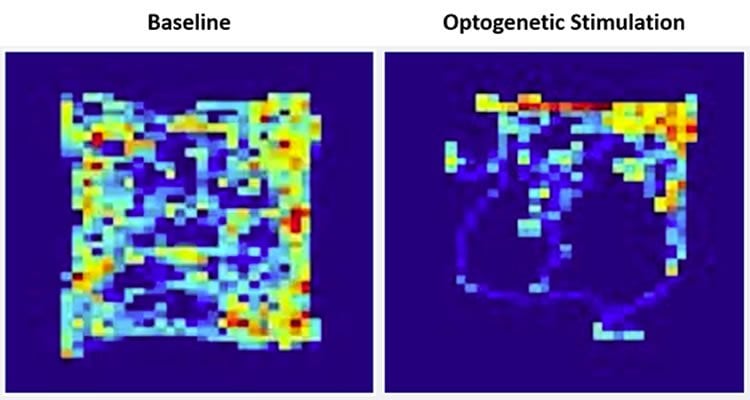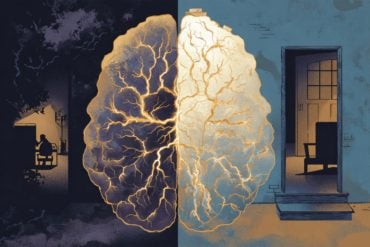Summary: Researchers reveal the role the cerebellum plays in helping to control the brain’s reward system. The researchers identified a direct connection from the cerebellum to the ventral tegmental area. The study may shed new light on neural networks associated with social dysfunction.
Source: NIH/NIMH.
A new study in rodents has shown that the brain’s cerebellum–known to play a role in motor coordination–also helps control the brain’s reward circuitry. Researchers found a direct neural connection from the cerebellum to the ventral tegmental area (VTA) of the brain, which is an area long known to be involved in reward processing and encoding. These findings, published in Science, demonstrate for the first time that the brain’s cerebellum plays a role in controlling reward and social preference behavior, and sheds new light on the brain circuits critical to the affective and social dysfunction seen across multiple psychiatric disorders. The research was funded by the National Institute of Mental Health (NIMH), part of the National Institutes of Health.
“This type of research is fundamental to deepening our understanding of how brain circuit activity relates to mental illnesses,” said Joshua A. Gordon, M.D., Ph.D., director of NIMH. “Findings like the ones described in this paper help us learn more about how the brain works, a key first step on the path towards developing new treatments.”
The cerebellum plays a well-recognized role in the coordination and regulation of motor activity. However, research has also suggested that this brain area contributes to a host of non-motor functions. For example, abnormalities in the cerebellum have been linked to autism, schizophrenia, and substance use disorders, and brain activation in the cerebellum has been linked to motivation, social and emotional behaviors, and reward learning, each of which can be disrupted in psychiatric disorders.
These earlier findings led Kamran Khodakhah, Ph.D., of the Albert Einstein College of Medicine, New York, and colleagues to wonder if there was a direct connection between the cerebellum and the VTA–a brain structure involved in controlling reward and motivational behaviors. To examine this, the researchers used a technique called optogenetics, in which the neurons of animals are genetically modified, so they can be controlled using pulses of light. The researchers used this technique in mice, activating neurons in the cerebellum which connected to the VTA. The researchers found that activating the cerebellar neurons led to increased activation in the VTA of mice, indicating a working connection between these two brain structures.
Once the neural connection between these two brain structures was confirmed, the researchers investigated whether inputs from the cerebellum to the VTA influenced reward-related and social preference behavior. The researchers placed mice in a square-shaped open chamber and used pulses of light to activate cerebellar neurons linked to the VTA whenever mice entered a specific part of the chamber, called the “reward quadrant.” Mice showed a strong preference for spending time in the reward quadrant, freely choosing to spend more than 70 percent of their time in this area. In addition, the researchers found that mice were willing to work for activation in this brain area and to spend time in conditions they would usually not prefer (light vs. darker areas) to receive this activation. Together, the findings suggest that activation of the cerebellar projections to the VTA is rewarding for mice and that the cerebellum plays a role in reward-related behaviors.
To examine whether the inputs from the cerebellum into the VTA impacted social behaviors, the researchers tested mice using a three-chamber social task in which the mice could choose to spend time in a chamber with another mouse (the social chamber), in an empty central chamber, or in a chamber containing a non-social object. At baseline, mice preferred to be in the social chamber, but after researchers inactivated the cerebellar projections into the VTA, the mice no longer showed this preference. In addition, continuous silencing of the cerebellar-VTA pathway was found to completely prevent the expression of social preference behavior in the mice, findings which indicate that inputs from the cerebellum into the VTA are necessary for social preference behavior in mice.

The results of this study suggest a potentially major–and previously unrecognized–role for the cerebellum in the creation and control of reward and social preference behaviors. Although there is much left to explore, the identification of this direct neural pathway may help explain the role of this circuit in disorders that involve reward-related and social-processing systems, such as addiction, autism, and schizophrenia, and may point to future targets for intervention and symptom management.
“The role of cerebellar circuitry in mental-health relevant behaviors is an understudied area, one in which we have just begun to see increased interest, said Janine Simmons, M.D., Ph.D., chief of the NIMH Social and Affective Neuroscience Program. “We are always excited to see innovation of this type in the behavioral neurosciences, and these results demonstrate how much remains to be learned.”
In future studies, the researchers plan to test whether the cerebellum-VTA pathway can be manipulated, using drugs or optogenetics, to treat addiction and prevent relapse after treatment.
“Cerebellar abnormalities are also linked to a number of other mental disorders such as schizophrenia,” said Dr. Khodakhah. “We want to find out whether this pathway also plays a role in those disorders.”
Funding: This work was supported by NIH/National Institute of Mental Health, NIH/National Institute of Neurological Disorders and Stroke, NIH/National Institute on Drug Abuse, National Center for Research Resources.
Source: Claire Cole – NIH/NIMH
Publisher: Organized by NeuroscienceNews.com.
Image Source: NeuroscienceNews.com image is credited to Albert Einstein College of Medicine.
Original Research: Abstract for “Cerebellar modulation of the reward circuitry and social behavior” by Ilaria Carta, Christopher H. Chen, Amanda L. Schott, Schnaude Dorizan, and Kamran Khodakhah in Science. Published January 18 2019.
doi:10.1126/science.aav0581
[cbtabs][cbtab title=”MLA”]NIH/NIMH”Surprising Role of the Cerebellum in Reward and Social Behaviors.” NeuroscienceNews. NeuroscienceNews, 17 January 2019.
<https://neurosciencenews.com/cerebellum-reward-social-10569/>.[/cbtab][cbtab title=”APA”]NIH/NIMH(2019, January 17). Surprising Role of the Cerebellum in Reward and Social Behaviors. NeuroscienceNews. Retrieved January 17, 2019 from https://neurosciencenews.com/cerebellum-reward-social-10569/[/cbtab][cbtab title=”Chicago”]NIH/NIMH”Surprising Role of the Cerebellum in Reward and Social Behaviors.” https://neurosciencenews.com/cerebellum-reward-social-10569/ (accessed January 17, 2019).[/cbtab][/cbtabs]
Abstract
Cerebellar modulation of the reward circuitry and social behavior
INTRODUCTION
Although the cerebellum has long been considered to be a purely motor structure, recent studies have revealed that it also has critical nonmotor functions. Cerebellar dysfunction is implicated in addictive behavior and in mental disorders such as autism spectrum disorder (ASD), cognitive affective syndrome, and schizophrenia. The cerebellum is well poised to contribute to behavior because it receives a wide array of cortical and sensory information and is subject to control by a number of neuromodulators. To perform its function, the cerebellum is believed to integrate these diverse inputs to provide the rest of the brain with predictions required for optimal behavior. Although there are many pathways for this to occur in the motor domain, fewer exist for the nonmotor domain.
RATIONALE
There are no direct pathways emanating from the cerebellum that have been shown to serve nonmotor functions. We hypothesized that the cerebellum may contribute to motivated behavior by a direct projection to the ventral tegmental area (VTA), a structure that is critical for the perception of reward and control of social behaviors. Such a projection would explain why functional imaging experiments indicate that the cerebellum plays a role in addiction and would provide one potential mechanism by which cerebellar dysfunction might contribute to the symptoms of mental disorders.
RESULTS
In mice, we found that monosynaptic excitatory projections from the cerebellar nuclei to the VTA powerfully activate the reward circuitry and contribute to social behavior. Using anatomical tracing, we showed that axonal projections from the cerebellar nuclei form synapses with both dopaminergic and nondopaminergic neurons in the VTA. The cerebello-VTA (Cb-VTA) projections were powerful and their optogenetic stimulation robustly increased the activity of VTA neurons both in vivo and in vitro. Behavioral tests to examine reward processing showed that stimulation of the Cb-VTA projections was sufficient to cause short-term and long-term place preference, thereby demonstrating that the pathway was rewarding. Although optogenetic inhibition of Cb-VTA projections was not aversive, it completely abolished social preference in the three-chamber test for sociability, which suggests that the cerebellar input to the VTA is required for normal social behavior. A role for the cerebellum in social behavior was also indicated by correlation between calcium activity in these axons and performance in the three-chamber test. However, optogenetic activation of the Cb-VTA inputs was not prosocial, hence the pathway was not sufficient for social behavior.
CONCLUSION
The Cb-VTA pathway described here is a monosynaptic projection from the cerebellum to a structure known primarily for its nonmotor functions. Our data support a role for the cerebellum in reward processing and in control of social behavior. We propose that this Cb-VTA pathway may explain, at least in part, the association between the cerebellum and addictive behaviors, and provides a basis for a role for the cerebellum in other motivated and social behaviors. In addition to contributing to reward processing, the VTA also targets a number of other brain regions, such as the prefrontal cortex, that in turn sustain a large repertoire of motor and nonmotor behaviors. Direct cerebellar innervation of the VTA provides a pathway by which the cerebellum may modulate these diverse behaviors. The Cb-VTA pathway delineated here provides a mechanism by which cerebellar dysfunction, by adversely affecting the VTA and its targets, might contribute to mental disorders such as ASD and schizophrenia.







